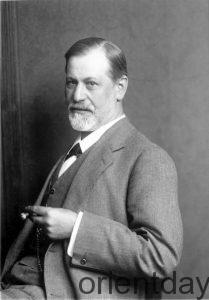Freud began his study of medicine at the University of Vienna in 1873.[94] He took almost nine years to complete his studies, due to his interest in neurophysiological research, specifically investigation of the sexual anatomy of eels and the physiology of the fish nervous system, and because of his interest in studying philosophy with Franz Brentano. He entered private practice in neurology for financial reasons, receiving his M.D. degree in 1881 at the age of 25.[95] Amongst his principal concerns in the 1880s was the anatomy of the brain, specifically the medulla oblongata. He intervened in the important debates about aphasia with his monograph of 1891, Zur Auffassung der Aphasien, in which he coined the term agnosia and counselled against a too locationist view of the explanation of neurological deficits. Like his contemporary Eugen Bleuler, he emphasized brain function rather than brain structure.
Freud was also an early researcher in the field of cerebral palsy, which was then known as "cerebral paralysis". He published several medical papers on the topic, and showed that the disease existed long before other researchers of the period began to notice and study it. He also suggested that William John Little, the man who first identified cerebral palsy, was wrong about lack of oxygen during birth being a cause. Instead, he suggested that complications in birth were only a symptom.
Freud hoped that his research would provide a solid scientific basis for his therapeutic technique. The goal of Freudian therapy, or psychoanalysis, was to bring repressed thoughts and feelings into consciousness in order to free the patient from suffering repetitive distorted emotions.
Classically, the bringing of unconscious thoughts and feelings to consciousness is brought about by encouraging a patient to talk about dreams and engage in free association, in which patients report their thoughts without reservation and make no attempt to concentrate while doing so.[96] Another important element of psychoanalysis is transference, the process by which patients displace onto their analysts feelings and ideas which derive from previous figures in their lives. Transference was first seen as a regrettable phenomenon that interfered with the recovery of repressed memories and disturbed patients' objectivity, but by 1912, Freud had come to see it as an essential part of the therapeutic process.[97]
The origin of Freud's early work with psychoanalysis can be linked to Josef Breuer. Freud cred Breuer with opening the way to the discovery of the psychoanalytical method by his treatment of the case of Anna O. In November 1880, Breuer was called in to treat a highly intelligent 21-year-old woman (Bertha Pappenheim) for a persistent cough that he diagnosed as hysterical. He found that while nursing her dying father, she had developed a number of transitory symptoms, including visual disorders and paralysis and contractures of limbs, which he also diagnosed as hysterical. Breuer began to see his patient almost every day as the symptoms increased and became more persistent, and observed that she entered states of absence. He found that when, with his encouragement, she told fantasy stories in her evening states of absence her condition improved, and most of her symptoms had disappeared by April 1881. Following the death of her father in that month her condition deteriorated again. Breuer recorded that some of the symptoms eventually remitted spontaneously, and that full recovery was achieved by inducing her to recall events that had precipitated the occurrence of a specific symptom.[98] In the years immediately following Breuer's treatment, Anna O. spent three short periods in sanatoria with the diagnosis "hysteria" with "somatic symptoms",[99] and some authors have challenged Breuer's published account of a cure.[100][101][102] Richard Skues rejects this interpretation, which he sees as stemming from both Freudian and anti-psychoanalytical revisionism, that regards both Breuer's narrative of the case as unreliable and his treatment of Anna O. as a failure.[103] Psychologist Frank Sulloway contends "Freud's case histories are rampant with censorship, distortions, highly dubious 'reconstructions,' and exaggerated claims."[104]
Seduction theory
In the early 1890s, Freud used a form of treatment based on the one that Breuer had described to him, modified by what he called his "pressure technique" and his newly developed analytic technique of interpretation and reconstruction. According to Freud's later accounts of this period, as a result of his use of this procedure most of his patients in the mid-1890s reported early childhood sexual abuse. He believed these stories, which he used as the basis for his seduction theory, but then he came to believe that they were fantasies. He explained these at first as having the function of "fending off" memories of infantile masturbation, but in later years he wrote that they represented Oedipal fantasies, stemming from innate drives that are sexual and destructive in nature.[105]
Another version of events focuses on Freud's proposing that unconscious memories of infantile sexual abuse were at the root of the psychoneuroses in letters to Fliess in October 1895, before he reported that he had actually discovered such abuse among his patients.[106] In the first half of 1896, Freud published three papers, which led to his seduction theory, stating that he had uncovered, in all of his current patients, deeply repressed memories of sexual abuse in early childhood.[107] In these papers, Freud recorded that his patients were not consciously aware of these memories, and must therefore be present as unconscious memories if they were to result in hysterical symptoms or obsessional neurosis. The patients were subjected to considerable pressure to "reproduce" infantile sexual abuse "scenes" that Freud was convinced had been repressed into the unconscious.[108] Patients were generally unconvinced that their experiences of Freud's clinical procedure indicated actual sexual abuse. He reported that even after a supposed "reproduction" of sexual scenes the patients assured him emphatically of their disbelief.[109]
As well as his pressure technique, Freud's clinical procedures involved analytic inference and the symbolic interpretation of symptoms to trace back to memories of infantile sexual abuse.[110] His claim of one hundred percent confirmation of his theory only served to reinforce previously expressed reservations from his colleagues about the validity of findings obtained through his suggestive techniques.[111] Freud subsequently showed inconsistency as to whether his seduction theory was still compatible with his later findings.[112] In an addendum to The Aetiology of Hysteria he stated: "All this is true [the sexual abuse of children]; but it must be remembered that at the time I wrote it I had not yet freed myself from my overvaluation of reality and my low valuation of phantasy".[113] Some years later Freud explicitly rejected the claim of his colleague Ferenczi that his patients’ reports of sexual molestation were actual memories instead of fantasies, and he tried to dissuade Ferenczi from making his views public.[112] Karin Ahbel-Rappe concludes in her study ""I no longer believe": did Freud abandon the seduction theory?’’: "Freud marked out and started down a trail of investigation into the nature of the experience of infantile incest and its impact on the human psyche, and then abandoned this direction for the most part."[114]
Cocaine
As a medical researcher, Freud was an early user and proponent of cocaine as a stimulant as well as analgesic. He believed that cocaine was a cure for many mental and physical problems, and in his 1884 paper "On Coca" he extolled its virtues. Between 1883 and 1887 he wrote several articles recommending medical applications, including its use as an antidepressant. He narrowly missed out on obtaining scientific priority for discovering its anesthetic properties of which he was aware but had mentioned only in passing.[115] (Karl Koller, a colleague of Freud's in Vienna, received that distinction in 1884 after reporting to a medical society the ways cocaine could be used in delicate eye surgery.) Freud also recommended cocaine as a cure for morphine addiction.[116] He had introduced cocaine to his friend Ernst von Fleischl-Marxow who had become addicted to morphine taken to relieve years of excruciating nerve pain resulting from an infection acquired while performing an autopsy. His claim that Fleischl-Marxow was cured of his addiction was premature, though he never acknowledged he had been at fault. Fleischl-Marxow developed an acute case of "cocaine psychosis", and soon returned to using morphine, dying a few years later after more suffering from intolerable pain.[117]
The application as an anesthetic turned out to be one of the few safe uses of cocaine, and as reports of addiction and overdose began to filter in from many places in the world, Freud's medical reputation became somewhat tarnished.[118]
After the "Cocaine Episode"[119] Freud ceased to publicly recommend use of the drug, but continued to take it himself occasionally for depression, migraine and nasal inflammation during the early 1890s, before discontinuing in 1896.[120] In this period he came under the influence of his friend and confidant Fliess, who recommended cocaine for the treatment of the so-called nasal reflex neurosis. Fliess, who operated on the noses of several of his own patients, also performed operations on Freud and on one of Freud's patients whom he believed to be suffering from the disorder, Emma Eckstein. The surgery proved disastrous.[121]
The Unconscious
Main article: Unconscious mind
The concept of the unconscious was central to Freud's account of the mind. Freud believed that while poets and thinkers had long known of the existence of the unconscious, he had ensured that it received scientific recognition in the field of psychology. The concept made an informal appearance in Freud's writings.
The unconscious was first introduced in connection with the phenomenon of repression, to explain what happens to ideas that are repressed. Freud stated explicitly that the concept of the unconscious was based on the theory of repression. He postulated a cycle in which ideas are repressed, but remain in the mind, removed from consciousness yet operative, then reappear in consciousness under certain circumstances. The postulate was based upon the investigation of cases of traumatic hysteria, which revealed cases where the behavior of patients could not be explained without reference to ideas or thoughts of which they had no awareness. This fact, combined with the observation that such behavior could be artificially induced by hypnosis, in which ideas were inserted into people's minds, suggested that ideas were operative in the original cases, even though their subjects knew nothing of them.
 或登录投递
或登录投递
版权声明:本文著作权归原作者所有,欢迎分享本文,谢谢支持丨www.jobsapk.com丨如未注明,均为原创 转载请注明:西格蒙德·弗洛伊德主要理论 | jobcolour








